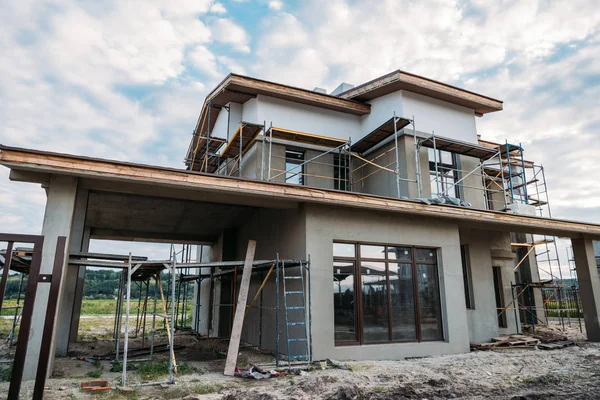
Home construction projects are exciting but can be riddled with unexpected delays and frustrations if not properly managed. From design issues to unforeseen site problems, delays can escalate costs and extend timelines, leading to stress. Fortunately, with the right planning and proactive steps, these headaches can be avoided.
This article will explore actionable strategies to help you avoid delays and ensure smooth progress during your house construction, especially when undertaking addition and alteration (A&A) works.
Plan Thoroughly Before Starting
A lack of comprehensive planning is a major contributor to construction delays. Begin with a detailed blueprint that covers every aspect of your house construction project. Ensure the design incorporates all necessary A&A works, whether expanding rooms, adding new features, or making structural alterations. Collaborate with your architect and contractor to anticipate potential challenges early, reducing the risk of unexpected delays once construction is underway.
Proper planning goes beyond the physical structure. Ensure all legal permissions, such as building permits and A&A work approvals, are secured. Without these in place, your project can face costly halts. Thorough planning also includes budgeting for potential surprises, which will help you avoid delays caused by financial setbacks.
Choose the Right Contractor
Selecting the right contractor is essential in avoiding delays and headaches during house construction. Contractors who value time and budget are worth looking for. Ensure they have experience with A&A works, as these tasks require specialised knowledge.
Interview multiple contractors before making a decision and request references from previous projects similar to yours. Clear communication with your contractor will also help avoid misunderstandings that could lead to delays. Establish a timeline with milestones and hold your contractor accountable for meeting those deadlines.
Set a Realistic Timeline
Setting a realistic timeline for your home construction project is crucial. Over-optimism can lead to disappointment when unforeseen events arise, such as bad weather, supply chain disruptions, or unexpected structural issues. Work with your contractor to create a flexible yet realistic timeline that allows for potential delays without affecting the overall completion date.
Avoid rushing the process. While you may want the project finished quickly, pushing contractors to work faster can compromise quality and lead to more significant issues later. A steady, well-paced schedule will reduce the risk of errors that require rework.
Source Materials Early

One of the most common causes of delays in house construction is the unavailability of materials. Whether due to supply chain disruptions or late orders, waiting for materials to arrive can halt progress. To avoid this, ensure that all materials needed for your project are sourced early.
Work closely with your contractor to create a detailed list of materials and order them well in advance. This is especially crucial if you require specialised items for your A&A works, such as custom windows or doors. Early sourcing not only reduces delays but can also help you avoid price hikes that occur closer to the construction date.
Communicate Regularly with Your Contractor
Clear and regular communication between you and your contractor is key to keeping the project on track. Lack of communication can result in misunderstandings, leading to mistakes and delays. Schedule regular meetings to discuss the progress and address potential issues before they escalate.
Ask your contractor for regular updates, and don’t hesitate to ask questions or clarify details. Effective communication will help you stay informed about timelines, challenges, and adjustments to the project. It also provides an opportunity to make decisions quickly, preventing unnecessary hold-ups.
Be Prepared for Unexpected Issues
No matter how thorough your planning is, unexpected issues are inevitable during home construction projects. Issues during A&A work in facing unexpected weather conditions, preparedness is crucial for the unexpected and can help minimise delays.
To avoid frustration, set aside a contingency fund and time buffer for such events. This ensures you have the resources to address unforeseen problems without derailing the entire project. A realistic approach to construction will help you manage setbacks without them turning into major delays.
BLOG: 3 A&A Projects Worth Considering for Your Landed Property
Monitor Progress Regularly
Regularly monitoring the progress of your home construction project is essential for catching potential delays early. While you don’t need to be on-site every \day, checking in will allow you to address issues before they escalate. If your contractor knows you are engaged and paying attention, they will be more likely to stay on schedule.
If possible, consider hiring a project manager or supervisor who can oversee the work daily. They will ensure that deadlines are met, quality standards are maintained, and delays are swiftly dealt with.
Avoid Last-Minute Changes
One of the biggest culprits for construction delays is making last-minute changes to the project. Changing your mind about materials, design, or layout during the construction process can cause significant disruptions. Contractors may need to rework parts of the project or order new materials, leading to extended timelines.
To avoid this, finalise all decisions before construction begins and stick to them. If changes are necessary, communicate them to your contractor as early as possible to minimise disruption. Remember, a well-managed construction project is one where every detail is addressed early to prevent unnecessary delays.
For more information about house construction solutions, contact Colebuild today.




